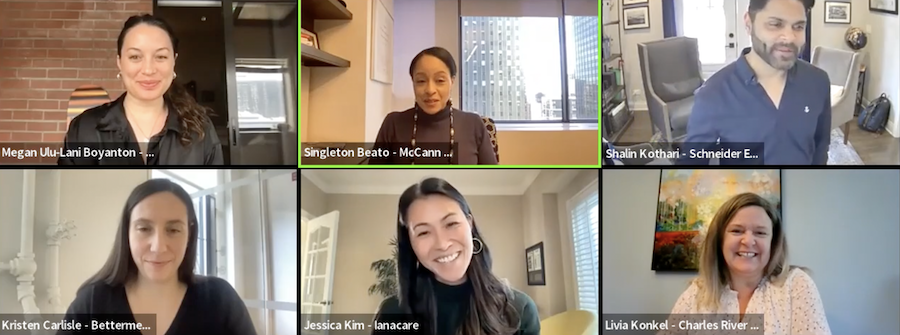Making the Employer-Value Proposition More Inclusive to the Diversity of Working Families


Jessica Kim has cared for her mother during her battle with cancer, has three kids, and is now caring for her 84-year-old father. “I am living for the need of caregiving support for all ages, all stages,” she told journalist Megan Ulu-lani Boyanton during a panel at a From Day One virtual conference. Kim’s personal story led her to establish ianacare, a platform that helps navigate care in the home for caregivers. ‘iana’ stands for “I am not alone,” and, while unique in its unfolding, her life experience is mirrored in the situations more and more workers are facing as they are navigating employment, caring for their offspring, and caring for their aging and/or ailing parents.
“I had my grandmother living with me until she passed at 92, my mother-in-law lives with me, and my son has ADHD and came out as part of the LGBTQ+ population,” replied Singleton Beato, global EVP and chief diversity, equity and inclusion officer at the global advertising communication company McCann Worldgroup. “I am living in the middle of ages, stages, and life experiences.”
Inequities affect the caregiving population, but organizations are striving to create benefit packages that meet and address their needs. Caregiving populations are part of workplace demographics that, while not faced with outward hostility, have suffered from neglect. “Many issues are cultural,” said Kim. “When we think about how we respond to neglect, we have to see how we approach it: not just data or checkboxes.”
Mental Health as a Springboard
“In the last few years, the common element was wellbeing and mental health,” said Livia Konkel, global diversity, equity, inclusion and corporate citizenship leader at the pharmaceutical company Charles River Laboratories. “Everything we do is centered on belonging and mental wellbeing. We have 5 pillars we work around: career, financial, physical, social, emotional. In all of that, we try to focus on benefits that will serve the whole person: one of the things we excel at is the emotional space.” On a related note, Charles River Laboratories eliminated the four-year degree requirements and added a tuition reimbursement for up to $20,000 “to make workplace easier to access,” said Konkel, herself a first-generation college graduate.

“Financial health is mental health is physical health,” said Kristen Carlisle, VP and general manager of the financial wellness benefits platform Betterment. “You’re not gonna be able to address every single thing, but you need to take time to step back: what’s working, what’s not working. 70% of people say their finances stress them. And when you are the employer, you say you do benchmarking, but in my own experience, I was making okay money but was also a caregiver and I was barely getting by.”
Taking a Holistic Approach
“What comes to mind when it comes to neglected demographics,” said Kim, “[is that] you don’t solve for what you don’t see: they don’t raise their hands and go to HR.”
It’s not an easy issue to address. “There is a lot of work to do: assessing the places in the world where the organization has facilities to understand what the underserved communities are, then building policies from there,” said Beato. “You need to make sure you understand what your folks need.” One example is making sure that one’s workplace and office building are, indeed, accessible to everyone on the spectrum of ability and disability. It’s also important to add policies and consideration for people going through menopause and to create gender-neutral facilities. “You need both the written policies and the physical conditions, [including] space to pray, and spaces where people like my son, who has ADHD, can collect themselves.”
The most obvious hurdle, in this instance, is funding. “Since the pandemic, people are more careful in how they spend their money. One of the things we need to improve is to make a business case showing how these implementations decrease healthcare costs, increase retention, and drive down attrition,” explained Shalin Kothari, vice president of people and DEI strategy at the digital automation company Schneider Electric. “We understate the cost of a new hire. There are a lot of hidden costs we don’t take into consideration.”
The Leading Role of Middle Managers
In order for these implementations to be successful and lasting, involvement has to go beyond executive leadership. “You have to ensure that your leaders are invested and also that they communicate and cascade their expectations down the chain to people’s managers, so that when these initiatives are pushed forward, the managers are going to help make the conditions and employees can take advantage of them,” said Beato. “A lot of executives are proponents of an inclusive culture,” said Kothari, backing up Beato. “Middle managers are often overwhelmed. Many of them today have a more diverse, multigenerational workforce, and the expectation is not just to manage their team, but to deliver as well.”
Given the way managing people has drastically changed in the last fifteen years, and will most likely continue to do so (compare managing six months into the pandemic to managing three years into it), “We decided to retain career coaching,” said Carlisle. This solution has been a way to help her own company’s middle managers. “We’re a benefits provider, and we provide our own: a whole lot of feedback!”
Angelica Frey is a writer and a translator based in Boston and Milan.
The From Day One Newsletter is a monthly roundup of articles, features, and editorials on innovative ways for companies to forge stronger relationships with their employees, customers, and communities.